By Ginger Dawson
NKyTribune reporter
In these Northern Kentucky river cities, we like our historic preservation.
Each city has a formal, designated entity to keep a close eye on the TLC, or lack thereof, of each old house that is in a designated historic district.
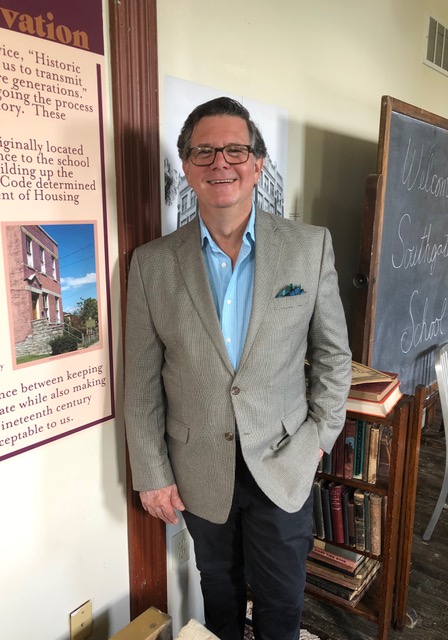
Scott Clark in the Newport History Museum @ the Southgate Street School. (Photo by Ginger Dawson)
Dayton, Kentucky has a five-citizen Board of Architectural Review. Bellevue has a similar arrangement with its six-member Historic Preservation Commission and Covington has gone a step further with an actual Preservation and Planning Specialist.
Newport, however, has taken it to an even greater degree of authority with a Historic Preservation OFFICER. There is a reason for this. Newport is the second-largest intact historic district in Kentucky, right behind Louisville, Kentucky’s Old Louisville Historic District. And, Old Louisville is the third largest historic district in the entire United States!
In preservation circles, this is a big deal.
We didn’t always value our great housing stock. During the second half of the 20th century, people migrated out to the suburbs and took money and business with them. As in all of the river cities, Newport’s old houses fell to neglect.
Newport’s story is the saddest. During the Victorian era, these were some of the finest homes in the entire area -— Ohio and Northern Kentucky.
Beautiful old Queen Anne and Italianate mansions, in many cases, were split up into multi-families -— some five and six units! They were rented and rented and abused and abused until no one saw anything of value in them anymore. They were the architectural equivalent of some of the old strippers or ladies of the demimonde from Newport’s Sin City heyday. Used up.
Many times, irreplaceable architectural gems were stripped from them and sold off. Tragic “remuddling” efforts which may have saved somebody a little money, further degraded them.
They made the area so undesirable that nobody even saw the value in tearing them down. This was their saving grace. Providence works in mysterious ways.
Fortunately, around the early to mid 1980’s, a movement to value and appreciate historic homes and architecture was gaining momentum across the entire country.
This focus finally came front and center in Northern Kentucky, probably just in time. Much earlier efforts by the National Trust for Historic Preservation (est. 1949) had become a part of the conversation of national heritage and identity. All locales with old housing stock were formalizing their response to this discussion. Of course, Newport was engaged.
Scott Clark has been Newport’s Historic Preservation Officer since 2011. Oddly enough, he has the distinction of being the only preservation officer who has actually resided in the city of Newport.
Naturally, he is passionate about history and architecture. This is enhanced by his patrician, yet casual, demeanor underscored by the charm of self-deprecation. By his manner, he exudes the dignity that a fine old Newport house appreciates after that era of gangsters and neglect.
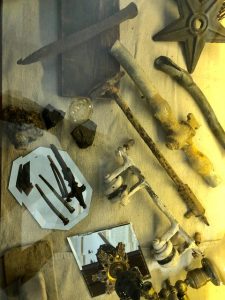
Artifacts of the preservation game. (Photo by Ginger Dawson)
And, as the first man of Newport Historic Preservation, he possesses a background and skill-set that has made him particularly effective in his mission. And, it is a mission. This is not just a job.
Growing up in Centerville, Ohio, Scott heard stories from both parents about his ancestors’ lives and accomplishments.
His mother’s family were in Kentucky from practically the beginning, migrating through the Cumberland Gap with Daniel Boone and ultimately settling in Mt. Sterling, just outside of Lexington.
His fathers’ family were New Englanders. His grandfather moved to Dayton, Ohio, when he accepted a position as a patent attorney for Delco, a division of General Motors, where he had the honor of writing the patent for Charles Kettering’s electric starter in 1911 (a big deal in the automotive world at that time).
The stories resonated and he developed a fine appreciation and interest in history, not just of his own family, but also the houses that were around them.
His interest in old homes came early. At the age of eleven, he focused on his grandparents 1870’s home in the City of Oakwood, a part of the Dayton metropolitan area. This was his first fascination.
It didn’t hurt that Oakwood was also the home of Orville Wright who had lived there in his beautiful Georgian Revival-style Mansion. Important history and homes had made their impression on him.
After Scott graduated from Centerville High School in Dayton, it was off to Otterbein College in Westerville, Ohio.
Old houses and history took a back seat. Scott received a Bachelor’s degree in business and public relations in 1982.
Even though history and old houses weren’t in the fore at the point, Scott says that “it was the best move he ever made”, in that he met his wife and best friend, Kendra. They married shortly after graduation. Thirty-eight years and counting!
Scott accepted a job as a trust officer with the Provident Bank in Cincinnati and he and Kendra moved to West Chester. This would a good place for them to raise their young family, a girl and a boy.
They built a new house, but this would not be your typical suburban home. Scott’s house would be in the Federal Style, featuring a central hallway and a formal design.
This old house business was an itch that would not go away.
For thirteen years, they stayed in West Chester. Finally, it was time to heed the call of the sirens. He and Kendra decided that he needed to pursue his true calling—historic preservation.
Now in the meantime, Scott had always done all of his own construction and renovation work. He was hands-on, and had developed considerable skill and knowledge. Now was the time to get serious about it as a career.

Scott at the Southgate Street School. (Photo by Ginger Dawson)
In 2000, the Clark family moved to a fine old Victorian Italianate townhouse in Newport. After establishing a year’s residency in Kentucky, he enrolled in the University of Kentucky in Lexington. Its program in its college of design was one of the few around that focused on the study of historic preservation.
Driving back and forth to Lexington (the ancestors’ old stomping grounds) he completed the course work.
During this time, he also started working for different contractors who specialized in historic properties. His knowledge and skill were highly valued and his experience continued to build.
Around 2009, he started a nine-year association with Habit for Humanity, the Christian-based housing organization. He was a weekend site manager at properties under renovation. It was unusual for the organization, in that Cincinnati and Newport (the two places he volunteered) were areas that historic renovation was a possibility. New-builds were the vast majority of Habitat’s projects.
When Scott became the Historic Preservation Officer for Newport, he continued on with Habitat. This turned out to be a particularly agreeable combination.
Homes in Newport that were suitable projects for Habitat for Humanity were also in historic districts. This meant that in his role as preservation officer, he would review building plans for suitability and compliance to historic guidelines, and then as site manage of the construction project; be sure that all was being done in the best way.
Since then, Scott has expanded his activities in Newport preservation by again combining his role as preservation officer with other projects in an effective synchronicity.
His volunteer work with the Newport History Museum @ the Southgate Street School (he is the Executive Director), was an artful orchestration of leveraging new development with preservation and history.
CRG Residential, a development company based in Indiana is developing apartments on the site of the former WPA (Works Progress Administration) era Fourth Street School.
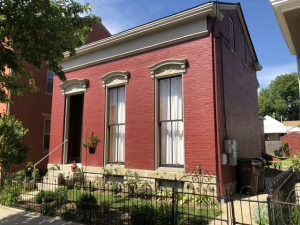
One of the Newport Habitat for Humanity homes that Scott site managed and reviewed for the city of Newport. (Photo by Ginger Dawson)
Part of the preservation requirements necessary to permit demolition of the 1939 building mandate that there be a little give and take. “We’ll let you do this, if you give us that.”
Scott Clark was able to, among other perks, get CRG to commit to doing a complete facade restoration and external brickwork on the Southgate School building, which had been damaged during a 1987 tornado. This would return it to its original appearance in its heyday as a school established in 1870 for African American students.
Other work is in the pipeline on this project, as well.
Here are links to two Northern Kentucky Tribune articles about the Southgate Street School: Newport History Museum and Southgate Street School.
Scott’s scholarly love of history (he reads four books at a time!) and passion for historic preservation are a formidable combination. But, let us not forget that this man has a degree in business and thirteen years in the banking world.
His skill set is just about as good as it gets for someone engaged in historic preservation. Newport has a renaissance man on their team.
Scott’s favorite quote is by the British designer William Morris (1834-1896)—“These old buildings do not belong to us only, they belong to our forefathers and they will belong to our descendants unless we play them false. They are not in any sense our own property to do with as we like with them. We are only trustees for those that come after us.”
Scott notes that this 1895 quote was proclaimed when just about every house under his watch was new. To him, this is not just a job, it is a mission.
A snippet of history from Newport’s real estate market, back in the day. Before the internet, Realtors subscribed to the Multiple Listing Service and received bound books with all of the latest activity. Check out the prices and comments! From 1992. The tide was turning. (Photos by Ginger Dawson)

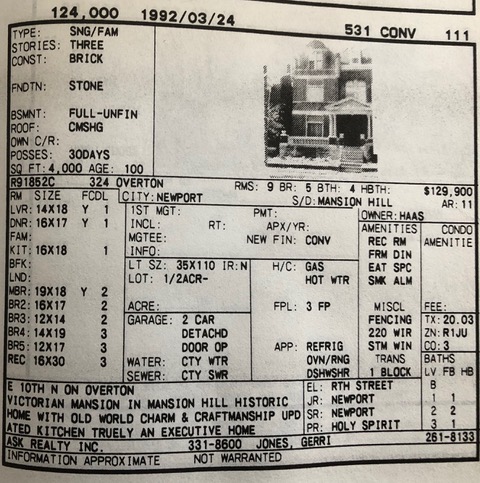
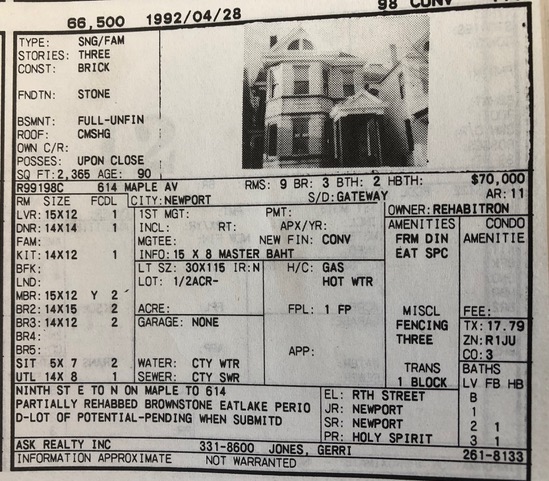
Ginger Dawson writes about people — the neighbors you need to know and people you need to meet and understand. If you have ideas for subjects please share them with Ginger at ginger@fuse.net.

























Kudos to Scott Clark for the fantastic work he has done in Newport. I note that the west side is taking on a new look, too…. Being a Ludlow resident, I noted that Ludlow was omitted from the list of groups in the river cities overseeing preservation efforts. Last year Ludlow’s historic district encompassing Elm St. to the river was made official. The city’s Urban Design Review Board has designated guidelines for property owners in the district who are working to preserve the original archtectural features of their houses.
Hi Ruth, I could not find any info on the city website to find out what Ludlow’s historic preservation efforts were for the article. I emailed the city to inquire, andI did not receive an answer. Sorry for the omission.
We are very fortunate to have Mr. Clark as our preservation officer! He is doing so much to make our city beautiful. Thanks to our city leaders as well!